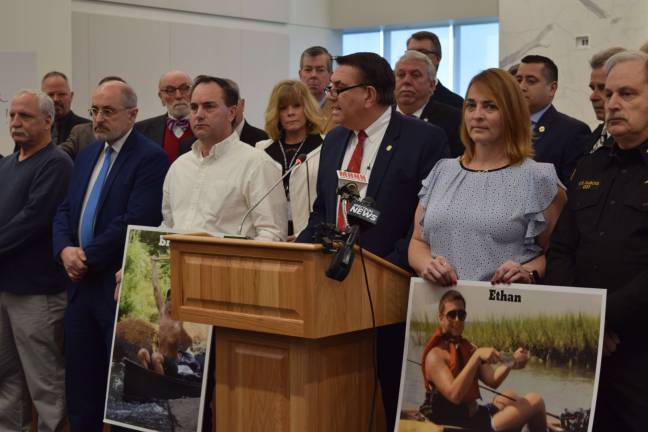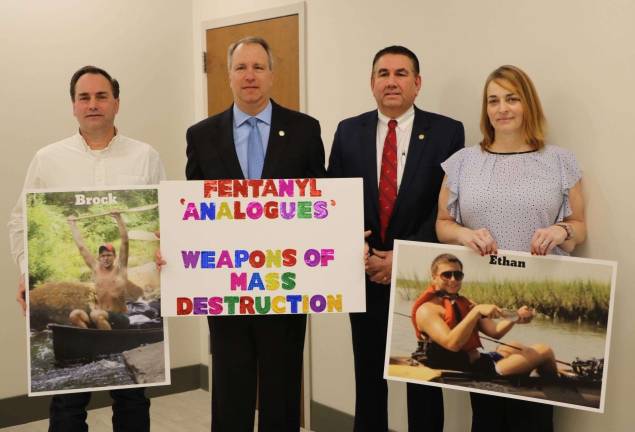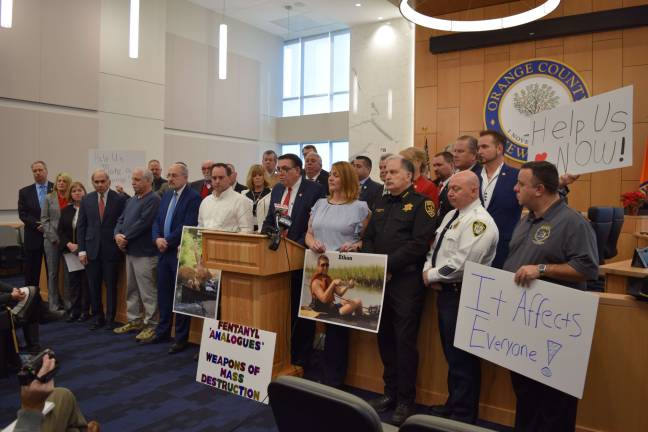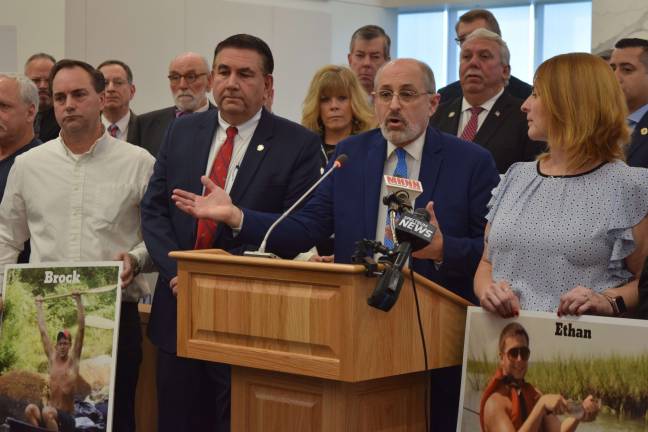Orange County urges state action on fentanyl ‘analogues’




BY ERIKA NORTON
GOSHEN — Orange County lawmakers are calling on the state Legislature and Gov. Andrew Cuomo to combat an obstacle contributing to the opioid epidemic — fentanyl “analogues.”
Fentanyl — now the most commonly used drug involved in drug overdoses according to Centers for Disease Control — is an extremely powerful opioid painkiller that is 100 times more potent than morphine. It is 50 times more potent than heroin.
And while fentanyl is a criminalized controlled substance, illegal drug dealers and chemists are creating slight variations, or analogues, of fentanyl that are just as deadly but skirt the law.
To try and get ahead of the drug chemists, the Orange County Legislature unanimously passed a resolution by a vote of 18-0 at its December meeting last week calling for New York State to classify certain fentanyl analogues as controlled substances.
18 fentanyl analogue cases “This problem, it kind of sounds like an esoteric problem, except when you realize that of the 102 people that died this year so far in Orange County of opiate overdoses, 18 of them died at least in part from one of these fentanyl analogues that was not illegal to be sold to them at the time that they took the drug,” said Orange County Executive Assistant District Attorney Robert Conflitti at a press conference last week.
“Frankly, I think it is a small part of the problem, but it’s a part of the problem that we can solve with very simple legislation that we’re calling on the state legislature to pass,” he said. “This idea has been floated before by the governor, but so far the state legislature hasn’t acted. We’re calling on them to do that today.”
Under federal law, the Administrator of the United States Drug Enforcement Administration has already lawfully defined “fentanyl-related substance” to mean any substance related to fentanyl by certain specified chemical modifications.
If New York State classified any substances that meets the above federal definition of fentanyl-related substance as controlled, the gap in the law with regard to fentanyl analogues would largely be closed, and law enforcement would be able to investigate and prosecute sellers these analogues that are responsible for many of the overdose deaths.
Orange County District Attorney David Hoovler said that out of the 18 who died in Orange County in part from a fentanyl analogues, at least one of those cases could have been prosecuted in the county if the analogue was classified as a schedule II drug.
“You may think that’s only one, but that’s one family, one person that meant something to someone,” Hoovler said. “Yes, it probably would have only been a drug sale charge, but it would have held somebody accountable.”
A son, a stepson, 11 former studentsFamilies who have lost loved ones to opioid overdoses involving fentanyl were also present at the press conference.
Michael Haney of Mount Hope lost his son Brock to an opioid overdose involving fentanyl in 2016 at the age of 25.
Laura Beck of Pine Bush lost her stepson Ethan to an opioid overdose involving fentanyl was involved at the age of 26.
Orange County Legislator Rob Sassi, who is chairman of the Legislative opioid addiction subcommittee, was a teacher for 32 years. He said he’s lost 11 former students to the opioid epidemic.
Assemblyman-elect Jonathan Jacobson as well as Assemblyman Karl Brabenec said they would sponsor the legislation when lawmakers convene in Albany in January.
Hoovler is also urging New York State to allocate more funding on prevention and enforcement in regards to the opioid crisis.
“We spend billions annually to help keep people from dying of cancer,” Hoovler said. “We spend billions annually and provide law enforcement with necessary tools to help prevent people from dying in car accidents. Well, thousands are dying from opioid overdoses, and the time has come to spend the money needed to prevent those deaths.”